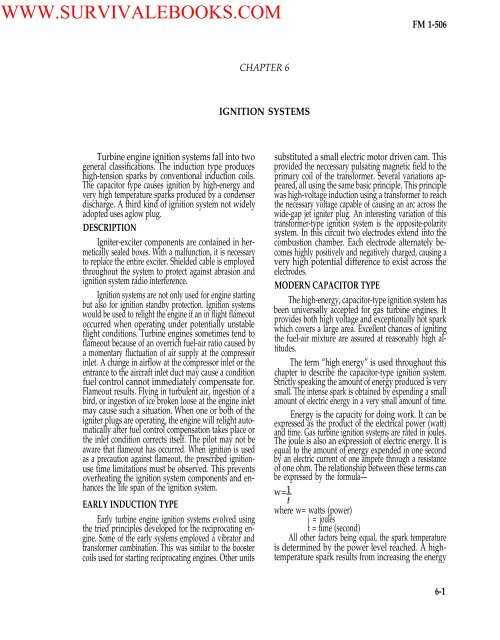FM 1-506 Fundamentals of Aircraft Power Plants ... - Survival Books
FM 1-506 Fundamentals of Aircraft Power Plants ... - Survival Books
FM 1-506 Fundamentals of Aircraft Power Plants ... - Survival Books
You also want an ePaper? Increase the reach of your titles
YUMPU automatically turns print PDFs into web optimized ePapers that Google loves.
WWW.SURVIVALEBOOKS.COM<strong>FM</strong> 1-<strong>506</strong>CHAPTER 6IGNITION SYSTEMSTurbine engine ignition systems fall into twogeneral classifications. The induction type produceshigh-tension sparks by conventional induction coils.The capacitor type causes ignition by high-energy andvery high temperature sparks produced by a condenserdischarge. A third kind <strong>of</strong> ignition system not widelyadopted uses aglow plug.DESCRIPTIONIgniter-exciter components are contained in hermeticallysealed boxes. With a malfunction, it is necessaryto replace the entire exciter. Shielded cable is employedthroughout the system to protect against abrasion andignition system radio interference.Ignition systems are not only used for engine startingbut also for ignition standby protection. Ignition systemswould be used to relight the engine if an in flight flameoutoccurred when operating under potentially unstableflight conditions. Turbine engines sometimes tend t<strong>of</strong>lameout because <strong>of</strong> an overrich fuel-air ratio caused bya momentary fluctuation <strong>of</strong> air supply at the compressorinlet. A change in airflow at the compressor inlet or theentrance to the aircraft inlet duct may cause a conditionfuel control cannot immediately compensate for.Flameout results. Flying in turbulent air, ingestion <strong>of</strong> abird, or ingestion <strong>of</strong> ice broken loose at the engine inletmay cause such a situation. When one or both <strong>of</strong> theigniter plugs are operating, the engine will relight automaticallyafter fuel control compensation takes place orthe inlet condition corrects itself. The pilot may not beaware that flameout has occurred. When ignition is usedas a precaution against flameout, the prescribed ignitionusetime limitations must be observed. This preventsoverheating the ignition system components and enhancesthe life span <strong>of</strong> the ignition system.EARLY INDUCTION TYPEEarly turbine engine ignition systems evolved usingthe tried principles developed for the reciprocating engine.Some <strong>of</strong> the early systems employed a vibrator andtransformer combination. This was similar to the boostercoils used for starting reciprocating engines. Other unitssubstituted a small electric motor driven cam. Thisprovided the neccessary pulsating magnetic field to theprimary coil <strong>of</strong> the transformer. Several variations appeared,all using the same basic principle. This principlewas high-voltage induction using a transformer to reachthe necessary voltage capable <strong>of</strong> causing an arc across thewide-gap jet igniter plug. An interesting variation <strong>of</strong> thistransformer-type ignition system is the opposite-polaritysystem. In this circuit two electrodes extend into thecombustion chamber. Each electrode alternately becomeshighly positively and negatively charged, causing avery high potential difference to exist across theelectrodes.MODERN CAPACITOR TYPEThe high-energy, capacitor-type ignition system hasbeen universally accepted for gas turbine engines. Itprovides both high voltage and exceptionally hot sparkwhich covers a large area. Excellent chances <strong>of</strong> ignitingthe fuel-air mixture are assured at reasonably high altitudes.The term “high energy” is used throughout thischapter to describe the capacitor-type ignition system.Strictly speaking the amount <strong>of</strong> energy produced is verysmall. The intense spark is obtained by expending a smallamount <strong>of</strong> electric energy in a very small amount <strong>of</strong> time.Energy is the capacity for doing work. It can beexpressed as the product <strong>of</strong> the electrical power (watt)and time. Gas turbine ignition systems are rated in joules.The joule is also an expression <strong>of</strong> electric energy. It isequal to the amount <strong>of</strong> energy expended in one secondby an electric current <strong>of</strong> one ampere through a resistance<strong>of</strong> one ohm. The relationship between these terms canbe expressed by the formula—w=1twhere w= watts (power)j = joulest = time (second)All other factors being equal, the spark temperatureis determined by the power level reached. A hightemperaturespark results from increasing the energy6-1
















